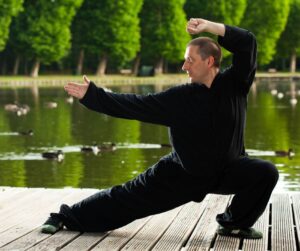For such a powerful and beautiful art, there are many common myths and misconceptions circulating about Tai Chi
Tai chi is still underrated as the fun route it actually is towards health, fitness, and happiness. Sadly, too many people of all ages are missing out on the numerous benefits this exercise system offers.
Here are 7 of the many misguided beliefs regarding Tai Chi…
Myth #1 – Too Slow To Be A Good Workout
In the west, many subscribe blindly to the no pain no gain mentality with no regards to the price being paid that comes with this way of thinking. Every injury sustained by pushing through simply lessens the intended gains, and often results in the quitting of one’s exercise regimen as the body can no longer cope.
When performed in a slow and deliberate manner, Tai Chi is more strenuous than it looks while providing a safer complete body workout from the inside out. The gentleness of the practice nurtures the human body. Improved strength, flexibility, aerobic conditioning, and balance are amongst the many benefits.
Have you ever seen the videos of the many very elderly Chinese people performing Tai Chi in the park? Their grace and ease of movement always as well as how stable they are on their feet fascinates me. Wouldn’t you love to be able to move like that in your retirement years?
Myth #2 – It’s Only For The Elderly
Don’t let the slow aspect of Tai Chi fool you. Remember that Tai Chi originates from martial arts.
As with any martial art, there are many layers to this practice.
Yes, it is an ideal practice for the elderly as it is very gentle and can be performed withing the capacity of the body of the participant.
However, younger participants can perform the moves (if their bodies  are able) in a more athletic manner.
are able) in a more athletic manner.
Many confuse slowness of movement with easiness of execution.
It is always amusing to see the astonishment in the faces of the first-time students. Their expectations of how easy this would be is completely challenged. And then, the other participants inform them of their understanding and that they will get it eventually if they just stick with it.
With that said, Tai Chi can be easy to learn, all you need is a bit of perseverance and a patient instructor.
Myth #3 – Tai Chi Is A Religious Practice
First and foremost, Tai Chi is a martial art and a great exercise practice.
The Tai Chi principles follow the Ancient Master’s understanding of the human body.
More and more, these days, science is proving and explaining what the Ancient Masters knew intuitively or simply from observations.
While some religions have adopted Tai Chi as one of their practices, those religions are not incorporated in Tai Chi
Myth #4 – It’s Just The Chinese Version Of Yoga
 While Tai Chi and yoga are both wonderfully beneficial exercises, they are nothing alike.
While Tai Chi and yoga are both wonderfully beneficial exercises, they are nothing alike.
Yoga consists of specific postures often held for a certain length of time.
On the other hand, Tai chi is a flow of continuous movements. Tai Chi is focused on water like fluidity.
“Running water never goes stale”
Myth #5 – Who Needs A Teacher? I’ll Just Learn It From YouTube…
There is no denying that having access to pre-recorded videos is a very useful tool. However, taking classes with a qualified instructor is always recommended.
While learning the form (the pattern of movements) can be done through a video, questions will always arise, whether it’s about how to perform a particular move or a need for modification of any movement to accommodate our personal needs.
A trained eye will see right away if a movement is performed incorrectly and will be able to gently guide the participant to make it safer and more effective.
While Tai Chi is one of the safest activities you can do, injuries are still a possibility.
Myth #6 – You Only Get The Benefits When You Do It Perfectly
Most people get benefits from the very first class they attend, even if it’s only the relaxation and calmness aspect of the practice. Since stress is responsible for many ailments in our modern society, if it’s the only benefit one gets from practicing Tai Chi, it’s already priceless.
only the relaxation and calmness aspect of the practice. Since stress is responsible for many ailments in our modern society, if it’s the only benefit one gets from practicing Tai Chi, it’s already priceless.
Just like Shrek, Tai Chi has layers.
But one must start at the beginning to be able to improve their practice.
First, the participant must learn the form. Then, with practice, he/she will learn to apply the principles to every move they make.
As the skills get perfected, the benefits grow.
Myth #7 – It’s All Mumbo Jumbo Made Up A Thousand Years Ago
Yes, the art of Tai Chi is old, but its age does not mean it is inaccurate.
These days, modern day science is proving more and more what the ancients knew intuitively.
It is now broadly accepted that stress is the underlying cause of many diseases and illnesses.
The studies on the Vagus Nerve in particular help explain and illustrate why Tai Chi and Qigong have a healing effect on the human body
So Now What?
Here you have it. Tai Chi is a mindful form of exercise that is gaining increasing recognition for its mental and physical health benefits.
Don’t let misguided beliefs stop you from trying Tai Chi and enjoying the numerous benefits of this beautiful ancient art. Try it for yourself and see how it makes you feel.
As for me, Tai Chi and Qigong are my lifeline.
They help with my overall wellness as well as keeping my chronic fatigue at bay and keeping my stress levels under control.
It makes me happy to practice Tai Chi and Qigong.
So do yourself a favour, don’t subscribe to these common myths and misconceptions regarding the beautiful art of Tai Chi, join a class and have a go!

